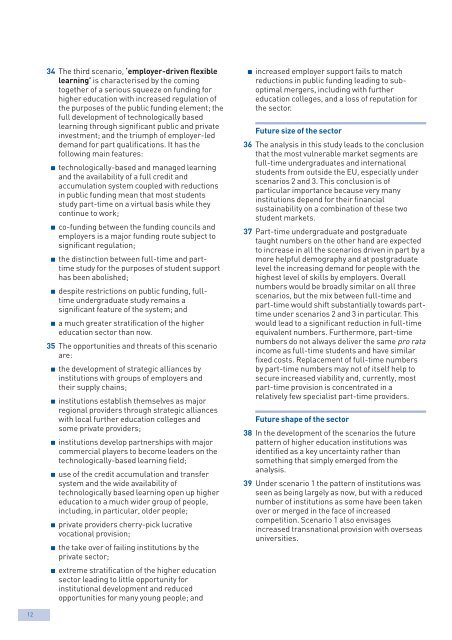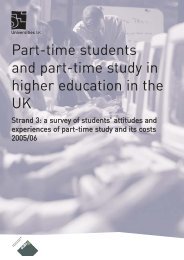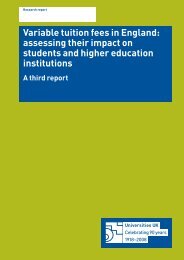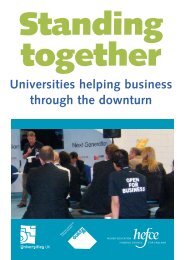The future size and shape of HE - Universities UK
The future size and shape of HE - Universities UK
The future size and shape of HE - Universities UK
- No tags were found...
You also want an ePaper? Increase the reach of your titles
YUMPU automatically turns print PDFs into web optimized ePapers that Google loves.
34 <strong>The</strong> third scenario, ‘employer-driven flexiblelearning’ is characterised by the comingtogether <strong>of</strong> a serious squeeze on funding forhigher education with increased regulation <strong>of</strong>the purposes <strong>of</strong> the public funding element; thefull development <strong>of</strong> technologically basedlearning through significant public <strong>and</strong> privateinvestment; <strong>and</strong> the triumph <strong>of</strong> employer-leddem<strong>and</strong> for part qualifications. It has thefollowing main features:p technologically-based <strong>and</strong> managed learning<strong>and</strong> the availability <strong>of</strong> a full credit <strong>and</strong>accumulation system coupled with reductionsin public funding mean that most studentsstudy part-time on a virtual basis while theycontinue to work;p co-funding between the funding councils <strong>and</strong>employers is a major funding route subject tosignificant regulation;p the distinction between full-time <strong>and</strong> parttimestudy for the purposes <strong>of</strong> student supporthas been abolished;p despite restrictions on public funding, fulltimeundergraduate study remains asignificant feature <strong>of</strong> the system; <strong>and</strong>p a much greater stratification <strong>of</strong> the highereducation sector than now.35 <strong>The</strong> opportunities <strong>and</strong> threats <strong>of</strong> this scenarioare:p the development <strong>of</strong> strategic alliances byinstitutions with groups <strong>of</strong> employers <strong>and</strong>their supply chains;p institutions establish themselves as majorregional providers through strategic allianceswith local further education colleges <strong>and</strong>some private providers;p institutions develop partnerships with majorcommercial players to become leaders on thetechnologically-based learning field;p use <strong>of</strong> the credit accumulation <strong>and</strong> transfersystem <strong>and</strong> the wide availability <strong>of</strong>technologically based learning open up highereducation to a much wider group <strong>of</strong> people,including, in particular, older people;p private providers cherry-pick lucrativevocational provision;p the take over <strong>of</strong> failing institutions by theprivate sector;p extreme stratification <strong>of</strong> the higher educationsector leading to little opportunity forinstitutional development <strong>and</strong> reducedopportunities for many young people; <strong>and</strong>p increased employer support fails to matchreductions in public funding leading to suboptimalmergers, including with furthereducation colleges, <strong>and</strong> a loss <strong>of</strong> reputation forthe sector.Future <strong>size</strong> <strong>of</strong> the sector36 <strong>The</strong> analysis in this study leads to the conclusionthat the most vulnerable market segments arefull-time undergraduates <strong>and</strong> internationalstudents from outside the EU, especially underscenarios 2 <strong>and</strong> 3. This conclusion is <strong>of</strong>particular importance because very manyinstitutions depend for their financialsustainability on a combination <strong>of</strong> these twostudent markets.37 Part-time undergraduate <strong>and</strong> postgraduatetaught numbers on the other h<strong>and</strong> are expectedto increase in all the scenarios driven in part by amore helpful demography <strong>and</strong> at postgraduatelevel the increasing dem<strong>and</strong> for people with thehighest level <strong>of</strong> skills by employers. Overallnumbers would be broadly similar on all threescenarios, but the mix between full-time <strong>and</strong>part-time would shift substantially towards parttimeunder scenarios 2 <strong>and</strong> 3 in particular. Thiswould lead to a significant reduction in full-timeequivalent numbers. Furthermore, part-timenumbers do not always deliver the same pro rataincome as full-time students <strong>and</strong> have similarfixed costs. Replacement <strong>of</strong> full-time numbersby part-time numbers may not <strong>of</strong> itself help tosecure increased viability <strong>and</strong>, currently, mostpart-time provision is concentrated in arelatively few specialist part-time providers.Future <strong>shape</strong> <strong>of</strong> the sector38 In the development <strong>of</strong> the scenarios the <strong>future</strong>pattern <strong>of</strong> higher education institutions wasidentified as a key uncertainty rather thansomething that simply emerged from theanalysis.39 Under scenario 1 the pattern <strong>of</strong> institutions wasseen as being largely as now, but with a reducednumber <strong>of</strong> institutions as some have been takenover or merged in the face <strong>of</strong> increasedcompetition. Scenario 1 also envisagesincreased transnational provision with overseasuniversities.12
















